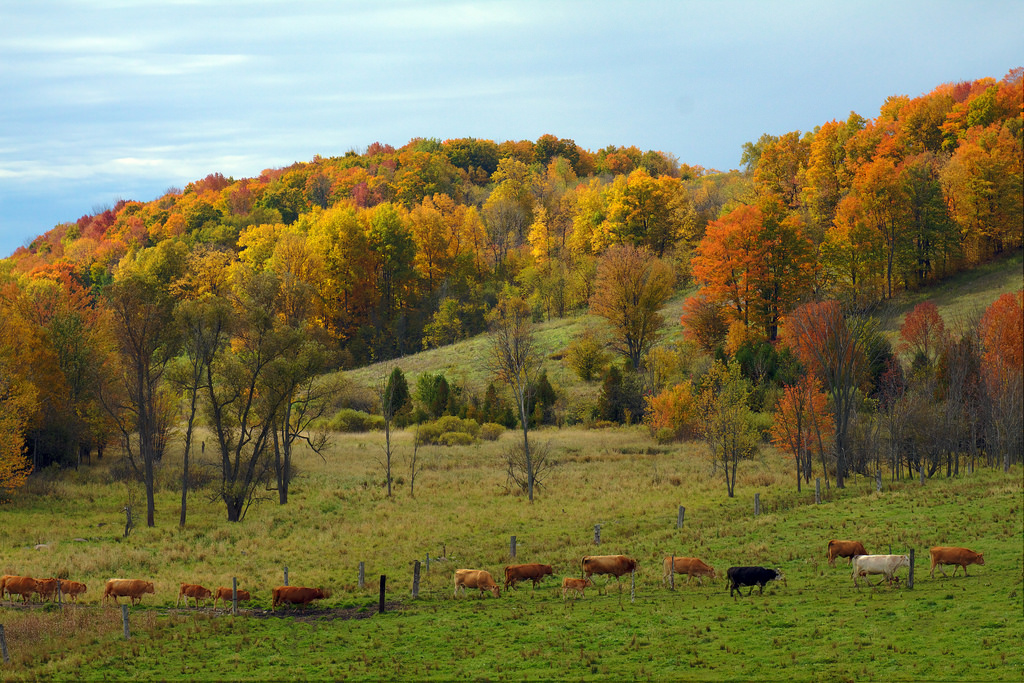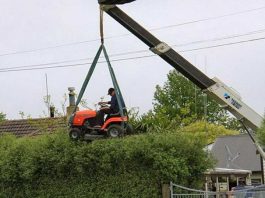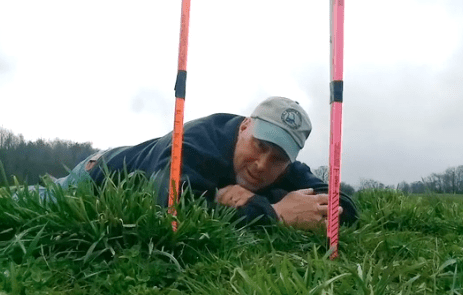
One of the greatest temptations in the fall is to “open the gates” and “let the livestock have the run of the pasture”. In terms of pasture for the following year, this is one of the most costly mistakes that can be made. Even in the fall, it is just as important to control the movement of the livestock through the grazing system as it is during the earlier parts of the grazing season. Here’s why proper fall grazing management is essential:
Residual Forage Protects the Soil to Provide for Spring Regrowth
Adequate residual stubble (at least 4”) or adequate trampled forage residues (at least 1,500 lb/A) on the pastures at this time of the season will modify the microclimate at the soil surface for better survival of the forages through the winter. The temperature at the soil surface will be more uniform than in an overgrazed pasture. This helps new buds, which are developed in the forage plant in the fall for the following spring, to survive. Many types of forage will grow a bud on the root or crown in the fall ready for growth right away in the spring. This bud can be damaged by extreme cold, fluctuations of temperature above and below freezing, desiccation, and physical crushing by livestock hoof action.

Residual Traps Snow More Effectively
Snow provides insulation for the soil surface and the new buds on the plants. The trapped snow also provides additional moisture in the spring. On average the lack of moisture is an issue more often than excess moisture in pastures. This strategy helps to create the moist conditions necessary for the plants to get a good start in the spring.
Adequate Residual Means Earlier Growth in Spring
Plant residues are a raw source of organic material for living organisms in the soil in the early spring. Without this they would suffer from lack of materials to “feed on”. They would not effectively perform the functions of recycling nutrients and mineralizing the soil to provide fertility for the plant to grow. Pastures with adequate residues left over winter will emerge 10-14 days earlier in the spring.
Soil Compaction is Greatly Reduced
When the livestock have access to the entire pasture, they will walk over it again and again, selecting the best of the remaining forage. This leads to compaction because they travel over the same areas many times. It does not take much compaction to effectively reduce infiltration of rainfall or snow- melt, and to effectively reduce the exchange of air between the soil and the atmosphere. The net effect is to reduce the available moisture for plant growth and to reduce the populations of organisms in the soil.
Root Reserves Are Protected
Root reserves in the plants will be reduced with continued grazing in the fall. This reduces plant vigor and spring growth.
What should you do to properly manage fall forage?
1. Maintain control of the livestock through the entire year.
 Continue to rotate them through the pasture system, paddock by paddock, in the fall until they have used the forages to the point where there is no more available forage. At this point the paddocks should all have the proper plant residuals, either residual stubble height (4”) or adequate residues trampled to the ground (1,500 lb/A).
Continue to rotate them through the pasture system, paddock by paddock, in the fall until they have used the forages to the point where there is no more available forage. At this point the paddocks should all have the proper plant residuals, either residual stubble height (4”) or adequate residues trampled to the ground (1,500 lb/A).
Opening the gates and letting animals have the run of the place puts a great deal of traffic pressure on the pastures and the livestock will tend to overgraze certain areas. Excess traffic causes com- paction which reduces air exchange in the soil and restricts rainfall infiltration. Opening the gates will significantly reduce pasture yields for the next grazing season.
2. Rest paddocks that need it.
This is a good time to rest the paddocks that have been damaged during the grazing season due to weather conditions or factors that disrupted the rotation of the livestock through the system.
Ideally, the pasture should be rested during September and into October. Because it is unlikely that the entire herd will be removed from the pasture at this time of the grazing season, I recommend that 20-25% of the pasture receive this treatment each year, rotating to different paddocks each year. Within 4-5 years, the entire pasture will be given this extended fall rest period. Livestock can continue to rotation- ally graze the remaining 75-80% of the pasture to a 4” residual stubble height. If there is not adequate forage, then remove the livestock from the pasture to a winter feeding area.
3. Plan your Fall grazing to enhance Spring regrowth.
Pastures that are allowed to rest for 30 days prior to a killing frost will emerge from winter dormancy 10-14 days earlier in the spring. This represents a significant extension of the grazing season.
The plant growth that accumulates in those paddocks given a fall rest should not be considered wasted. After mid-October the growth can be grazed to a 4” residual stubble height. This provides adequate forage for livestock on maintenance rations, such as dry cows, ewes, or horses, while it still leaves an adequate cover to buffer the effects of winter.
4. Use crop residue to extend your grazing season.
If alternative sources of forage (corn stalks or soybean residues, hayfields that will be tilled out next season, etc.) are available at this time, use them to give your pastures a longer rest period than they would normally have.

5. Select your sacrificial winter paddock.
The first goal for overwintering livestock is to keep them in the pasture for as long as possible, without grazing below a 4” residual stubble height. When there are no more forages to graze in the pasture, including stockpiled forages, the livestock need to be placed somewhere for the duration of the winter.
One option is feed them stored feed on a portion of the pasture. The first step of this overwintering method is to place round bales of hay in the area that will be used for the overwinter site prior to the onset of winter. Temporary electric fence can be used to give livestock access to bales. As the bales are consumed, the temporary fence is moved to allow access to additional bales.
Check out this past On Pasture article for tips on successful winter bale grazing:
 We hope this helps you with your fall season. If you have tips to share, we’d love to see them in the comments below!
We hope this helps you with your fall season. If you have tips to share, we’d love to see them in the comments below!




